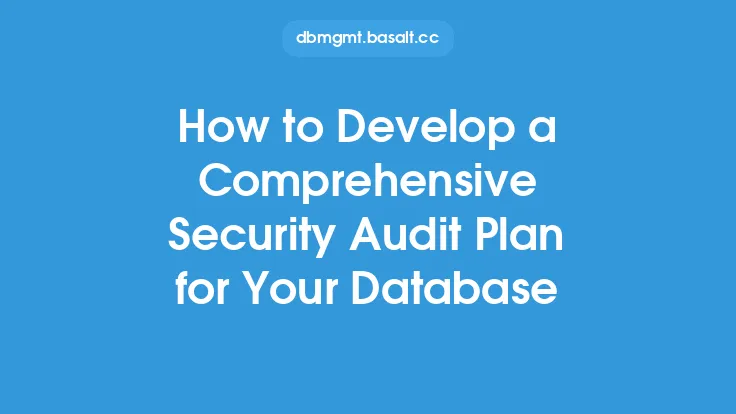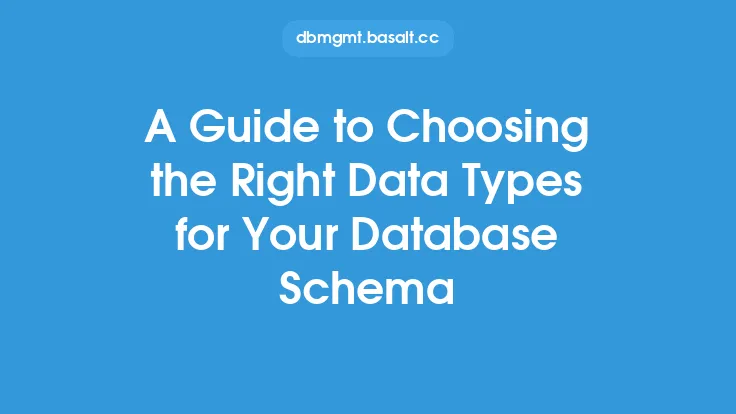When it comes to implementing a database for a business, one of the most critical decisions is choosing the right type of database. With so many options available, each with its own strengths and weaknesses, selecting the most suitable database can be a daunting task. A strategic approach to matching database types to business needs is essential to ensure that the chosen database meets the organization's requirements and supports its long-term goals.
Understanding Database Types
There are several types of databases, each designed to serve specific purposes. Relational databases, such as MySQL and PostgreSQL, are ideal for storing structured data and supporting complex transactions. They use a fixed schema, which defines the relationships between different data entities, and are well-suited for applications that require strong data consistency and adherence to ACID (Atomicity, Consistency, Isolation, Durability) principles. On the other hand, NoSQL databases, such as MongoDB and Cassandra, are designed for handling large amounts of unstructured or semi-structured data and provide flexible schema designs. They are often used in big data and real-time web applications where data is constantly changing and high scalability is required.
Assessing Business Needs
To match the right database type to business needs, it's essential to assess the organization's requirements. This involves identifying the types of data that need to be stored, the expected volume and velocity of data, and the required level of data consistency and durability. Businesses should also consider their scalability needs, as well as the complexity of their data models. For example, a simple e-commerce application may require a relational database to store customer information and order data, while a complex IoT application may require a NoSQL database to handle large amounts of sensor data.
Database Selection Criteria
When selecting a database, businesses should consider several key criteria. These include data structure, scalability, performance, security, and cost. The chosen database should support the required data structure, whether it's structured, semi-structured, or unstructured. It should also be able to scale to meet the growing needs of the business, both in terms of data volume and user base. Performance is another critical factor, as the database should be able to handle the required number of transactions per second and provide fast query response times. Security is also essential, as the database should provide robust access controls, encryption, and auditing capabilities to protect sensitive data. Finally, the cost of the database, including licensing fees, hardware, and maintenance costs, should be carefully evaluated to ensure it fits within the organization's budget.
Database Architecture
The database architecture is another critical aspect to consider when matching database types to business needs. This involves designing the overall structure of the database, including the relationships between different data entities, the data flow, and the storage and retrieval mechanisms. A well-designed database architecture can help improve data consistency, reduce data redundancy, and enhance query performance. It can also help ensure that the database is scalable, secure, and easy to maintain. There are several database architectures to choose from, including centralized, distributed, and cloud-based architectures. Each has its own advantages and disadvantages, and the chosen architecture should align with the business's overall IT strategy and goals.
Data Modeling
Data modeling is the process of creating a conceptual representation of the data that will be stored in the database. It involves identifying the entities, attributes, and relationships that make up the data, as well as the rules and constraints that govern the data. A well-designed data model can help ensure that the database is structured correctly, that data is consistent and accurate, and that queries are optimized for performance. There are several data modeling techniques to choose from, including entity-relationship modeling, object-relational modeling, and dimensional modeling. Each has its own strengths and weaknesses, and the chosen technique should align with the business's data management goals and objectives.
Implementation and Maintenance
Once the right database type has been selected, and the database architecture and data model have been designed, the next step is implementation and maintenance. This involves setting up the database, loading the data, and configuring the security and access controls. It also involves ongoing maintenance tasks, such as backups, indexing, and query optimization. The implementation and maintenance process should be carefully planned and executed to ensure that the database is available, secure, and performing optimally. This may involve working with database administrators, developers, and other stakeholders to ensure that the database meets the business's requirements and supports its long-term goals.
Conclusion
In conclusion, matching database types to business needs is a critical aspect of database implementation. By understanding the different types of databases, assessing business needs, and considering key selection criteria, businesses can choose the right database to support their operations and drive success. A well-designed database architecture, data model, and implementation plan can help ensure that the database is scalable, secure, and easy to maintain. By taking a strategic approach to database selection, businesses can unlock the full potential of their data and achieve their goals.





